LITURGY

Box reliquary
- Late 12th– early 13th century
- Champlevé*, enamel and gilded copper
- Limoges
Box reliquaries traditionally have the shape of a small house with a roof with two slopes and an open-work ridge above it. The roof can be raised to open the reliquary and can be locked with a hasp shaped like a monster’s head.
Relics (parts of the body or an object) of a saint were kept in it.
*Champlevé is a technique that consists in removing a small amount of material and inlaying enamel.
La technique du champlevé :
![]()
Evêques présentant les reliques dans des Châsses
Champlevé technique:
The champlevé technique involves cutting out cavities in a metal, most often in copper plate. The cavities are then filled with enamel (a coloured, glass-like material), leaving a design formed by the edges of the metal, which are gilded with mercury.
Limoges, a major medieval centre of champlevé enamel
From the mid-12th century, Limoges was the main centre for the champlevé enamel technique. Its workshops made numerous pieces that were exported all over Europe until the mid-14th century.
Mention is made of « Work of Limoges » (Opus lemovicense) in documents from 1169. The success of these objects was especially due to the simple, inexpensive materials used (copper and glass for the enamel). Once transformed by the Limousin craftsmen, the pieces resembled gold and precious gems because of the bright colours. In 1215, moreover, the Council Latran IV authorised the use of champlevé enamel in liturgical objects.
The production from Limoges was abundant and resulted in a wide range of objects, generally of a religious nature, and especially box reliquaries, but also pyxes, crosses, book covers, etc. One can also come across secular objects made in the Limousin workshops.

Quatrefoil cross
- Late 13th– early 14th century
- Wood, champlevé copper, enamel, gilding
- Limoges
- Ht: 31.8cm
This devotional cross shows Christ crowned in the centre with the four Evangelists in the four lobes at the ends of the arms of the cross.

Central metal plate of a cross
- First quarter of 13th century
- Champlevé copper, blue, green and red enamel, traces of gilding
- Limoges
- Ht. 18.5cm
This liturgical artistic object shows Christ crucified. The element was fixed at the centre of a cross.
Christ’s head is haloed and leaning slightly towards his right shoulder. His abdomen is swollen, the left leg bent and the feet are apart.

Pyxes
- 13th century
- Engraved and gilded copper; champlevé enamel
- Limousin workshop
A pyxe is a small recipient containing the hosts for the Eucharist. The sacred aspect can be seen here with the cross on top of one of them, while the other has been lost.
![]()
Pyxe Helie of Toulouse making an incantation (France, Paris. Bibliothèque de l’Arsenal, 3479 f.592)
Limoges was a major centre for making enamel objects using the champlevé technique. These objects were exported all over western Europe from the 12th century, enjoying great success from the 13th until the 15th century.

Aquamanile
- 12th century
- Brass
- Northern Germany or Denmark
An aquamanile (from the Latin aqua « water » and manus « hand ») is a recipient, generally made of metal, in which priests washed and purified their hands before and during mass. This ewer-type aquamanile originated in the Middle East and was adopted in Europe during the Middle Ages.
Many aquamaniles are in the form of a lion, like this one, but others feature a range of real or imaginary animals, such as dragons.
![]()
Besançon BM MS.54 Psalter Bonmont folio 11v-2 Germany 1260
The opening to let out the water is hidden in the lion’s mouth. To fill the recipient, a valve (now lost) on the head was opened. There is a handle in the form of an animal on the back of the aquamanile.
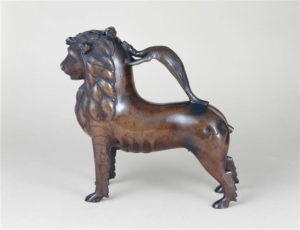 A lion aquamanile, 1240/1260, bronze, Lower Saxony (Germany), Louvre Museum.
A lion aquamanile, 1240/1260, bronze, Lower Saxony (Germany), Louvre Museum.
The aquamanile is made of melted and engraved bronze. It features a lion, with the handle made like a small dragon, curved into the arc of a circle and biting the back of the lion’s head. The lion is firmly positioned on its paws with its mouth half open. Its mane is made up of thick and supple locks, with the first row forming a kind of ruff around the animal’s head. The tail has been broken. The tear ducts, whiskers, nostrils and waves of fur on the paws are highlighted with engraved lines. There is a hole between the ears, fitted with a lid (the hinges have been replaced) where the recipient was filled. The water came out again through a spout emerging from the lion’s forehead.
Other kinds of aquamaniles:
Dragon aquamanile
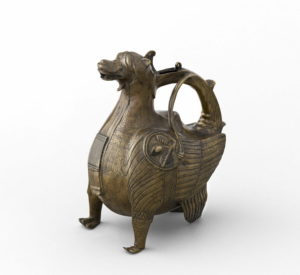
Aquamanile: dragon, often known as a griffon, about 1200, bronze or copper, Lower Saxony (Germany), Louvre Museum.
The aquamanile in the Louvre is one of a large family of objects of this kind in the form of a dragon, made in Lower Saxony, particularly in Hildesheim in the 12th and 13th centuries. It has the head and tail of a dragon with ears or ear tufts. This kind of monster has often been described as a « griffon » since the 19th century. Strictly speaking, it is a four-legged animal with the torso and feet of a bird and the hind quarters of a lion. A dragon, on the other hand, has the two front paws of a lion and two wings behind.
The opening where the recipient was filled has now lost its valve. Water was removed via the mouth. The griffon’s tail ends in a plant coil to form the handle.
Art aquamanile
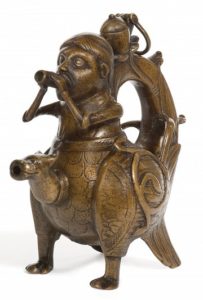
Aquamanile, early 13th century, bronze, Germany, Museum of Decorative Arts, Paris.
The aquamanile in the Museum of Decorative Arts is a significant and unique model. An imaginary bird with a human face holds in its very slender arms a kind of bottle neck that is used as an air vent; a second animal’s head between the two paws acts as a spout. The bird’s wings and tail are curved to form the handle of the aquamanile and contain the opening with a moveable lid into which the water was poured.

Reliquary base
- 12th century
- Champlevé copper, gilding
- Limoges
This base was used to house a speech scroll, a strip of parchment with rolled ends inscribed with Bible verses. Echoing the scroll, each side of the base is decorated with an Evangelist holding a parchment in his hands.
![]()
« Réponses à Charles VI et Lamentation au roi sur son état » par Pierre le Fruitier, dit Salmon, 1405-1415
Les évangélistes
The Evangelists, Mark, Luke, Matthew and John, wrote the four Gospels in the New Testament (Bible), relating the life and teaching of Jesus Christ.
The Evangelists are often depicted, not in human form, but allegorically: a lion for Mark, a bull for Luke, a man for Matthew and an eagle for John.
These depictions are inspired by a vision of the prophet Ezechiel in the Old Testament, with four identical, celestial creatures, each with the four legs of a bull, the four wings of an eagle, four human hands and four different faces of a man, a lion, a bull and an eagle. These four « living forms » or Tetramorph have their place at the foot of the throne of God.
This vision was taken up in the Apocalypse according to Saint John, but this time the living beings were not identical: « And the first beast was like a lion, and the second beast like a calf, and the third beast had a face as a man, and the fourth beast was like a flying eagle.«
Later, the 5th century Church Fathers associated the four creatures with the Evangelists, according to what they had written in their Gospels:
- Mark is associated with the lion because his gospel begins in the desert;
- Luke is associated with a bull because the beginning of his gospel refers to sacrifice, and the bull is the animal that was sacrificed;
- Matthew is associated with a man because his gospel begins with the genealogy of Christ;
- John is associated with the eagle because it is said that it is the only animal that can look at the sun without burning its eyes. It is a reference to the apostle’s ability to contemplate the mystery of God, the elevation of the divine Word and his preaching.

Small candle-holder with spike
- 13th century
- Bronze and iron

Candle-holder with hexagonal base
- Early 14th century
- Champlevé enamel and gilded copper
- Limoges
The candle was placed on the spike in the candle-holder, and the melted wax ran down into the dish.
The pyramid-shaped candle-holder has a hexagonal base decorated with coats of arms on all six sides.

Box reliquary
- 13th-early 14th century
- Wrought iron
This casket was once painted in different colours. Its length, its wide feet and saddle-roof design made it resemble a small safe, protecting the precious treasure it contained. Interesting repairs at the rear made long ago show that the chest had been forced open, probably to rob it of its relics. The primitive design on the reliquary suggest it was made for a fairly humble chapel.
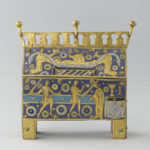

Ring
- 15th or 16th century
- Brass?
- Donated by Pierre Malrieu
Jewel with the engraved inscription IHS.
IHS is a monogram of Christ that the Catholic Church interpreted as Iesus, Hominum Salvator (Jesus, Saviour of Men) but takes its origin from the first three letters of Jesus’ name in Greek.

Set of pilgrim’s ampullae
- 14th century
- Lead
Pilgrim’s ampullae were vials in which pilgrims could bring back holy water, holy oils or even relics from their pilgrimages (soil, wood, fabrics, etc.). They could be hung around the neck by the handles or tied to the pilgrim’s hat.
They were sometimes decorated with fleur-de-lis and were shaped like purses or shells in reference to the Way of Saint James pilgrimage. The shell was the most widespread medieval symbol of the pilgrimage.
Ampoule de pèlerinage à décor de fleur de lys...
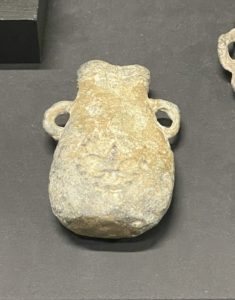
Pilgrim’s ampulla decorated with fleur-de-lis
- Medieval period
- Lead
- Ht. 5.6cm
- Donated by Pierre Malrieu
Here it is decorated with fleur-de-lis. It was worn around the neck with a cord tied to the handles. It contained holy oils or holy water that had been in contact with relics.
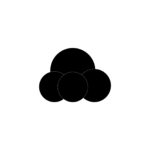
Set of a dish and three offering bowls
- About 1500
- Brass
- Nuremberg, Germany
Usage differed, depending on the decoration and the theme. These dishes were not only made for religious services, but could also be used to reflect light or for decorative purposes. But here the religious theme shows that it was used to carry the bread or host during baptisms, communions or for the collection.
Dish with the Paschal Lamb:
The Paschal Lamb is a powerful Christian symbol representing Jesus Christ, the « Lamb of God », who sacrificed himself to redeem humanity’s sins (in reference to the lamb as a sacrificial animal). The adjective « Paschal » refers to Pascha (Easter), when Christ died and was resurrected.
The Paschal Lamb is shown here with a halo and carrying a banner, as was often the case in the Middle Ages.
Offering bowl with Adam and Eve:
According to the book of Genesis in the Bible, they were the first man and woman created by God. We can see them here in the Garden of Eden, on either side of the tree of the knowledge of good and evil. They each have the forbidden fruit in their hands, while the serpent, the symbol of evil and temptation, is curled around the tree trunk. This founding event in the Bible led to the Fall of man, condemning men to hard toil and women to painful childbirth.
Offering bowl with the grapes of Canaan:
In the Bible, Canaan is the land promised to the Jews by God. Moses sent messengers to explore Canaan. They returned with a huge bunch of grapes, which two of them carried on a pole.
Offering bowl with the Annunciation:
This bowl represents the Annunciation, when the Archangel Gabriel announced to Mary that she would conceive and that her child would be called Jesus, the Messiah. This is a very important episode in Christianity and is often depicted in the same way: to the left is the Archangel Gabriel, to the right is Mary and above them the dove of the Holy Ghost sending forth rays, since Mary conceived « through the Holy Ghost ».

